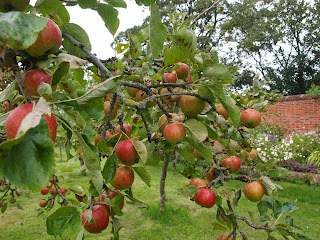A record of wildlife in my garden and various trips to the Warwickshire countryside and occasionally further afield.
Sunday, 24 August 2014
Castle Bromwich Hall Gardens in late Summer
I paid a very brief visit to Castle Bromwich Hall Gardens one afternoon last week - it was drizzling slightly when I arrived but the rain stopped half way round the gardens and the sun eventually came out.
Part of the Courtyard by the Visitor Centre
Verbena bonariensis and seedheads
There are two of these Pineapple stone sculptures in the Melon Grounds. They were originally placed on the Birmingham Road entrance gates to Castle Bromwich Hall.
The North Orchard is planted with varieties of apple and pear trees that would have been available to gardeners in 1740 when the gardens were in their prime.
If you enlarge this photo there is a plan of some of the apple varieties grown today.
Espalier pears line two sides of the orchard
I walked round the Extra Gardens - the informal gardens outside the walled garden
I took a few photos of various seedheads - I do love seedheads and the way they all vary in colour, shape and form. We leave seedheads in the garden at home over the winter to provide hibernating places for insects and food for finches - goldfinches in particular often feed on them.
Sloes
This little fruit that looks like a cross between a strawberry and a raspberry is the fruit of the Black Mulberry Tree
New Orchard - I saw lots of Speckled Wood butterflies in this area - perhaps attracted to the rotting windfall apples on the ground.
Back in the Walled Garden - the Kitchen Garden
Cyclamen are flowering in the Upper Wilderness
The white trellis surrounds what remains of a Gazebo
Echinops is going to seed. From the two plants I put in our garden at home I have the grand total of one flower!! I am hoping they will become more established next year and I'll get a lot more flowers.
For more information on Castle Bromwich Hall Gardens please visit www.cbhgt.org.uk
Harebells
After leaving the Gardens I stopped off at an area of common land where I used to walk as a child. I often used to see harebells flowering here in late summer and I was really pleased to see that lo and behold they are still growing here. I love their fragile, delicate, nodding blue bells. I am sure they occur elsewhere locally but this is the only place I have seen them growing in the wild.
Harebell - Campanula rotundifolia
The flowers provide a source of nectar in autumn for bees. Folklore suggests that fairies make hats from the flowers and the bells sound a warning to hares when danger is close. The flowers are also known as Witch Bell or Witch's Thimble perhaps suggesting more sinister associations.
William Wordsworth mentioned seeing harebells in "The Prelude"
"Or, not less pleased, lay on some turret's head,
Catching from tufts of grass and hare-bell flowers
Their faintest whisper to the passing breeze,
Given out, while mid-day heat oppressed the plains."









































Those fruit trees look healthy don't they. Great seed heads too and cyclamen plants are flowering here now, but they look pretty in the wilderness area in such large numbers.
ReplyDeleteSeagullSuzie - Many thanks. Yes the fruit trees do look healthy - and another good crop this year :) I like cyclamen plants en masse too - sadly they never do very well in our own garden :(
ReplyDeleteYou've done better than me with your echinops- not a single flower here. I noticed harebells when m and I were out walking yesterday- such pretty, delicate flowers. The gardens look fab in your post- my pots are still colourful but the beds are fading now. :-)
ReplyDeleteCountryside Tales - Thanks - to be honest the echinops flower isn't very big!! Blink and you'd miss it! Our garden here at home looks more like September than August - as flowers fade :( Buddleia and verbena still flowering well though and ice plants and asters are just starting.
ReplyDelete